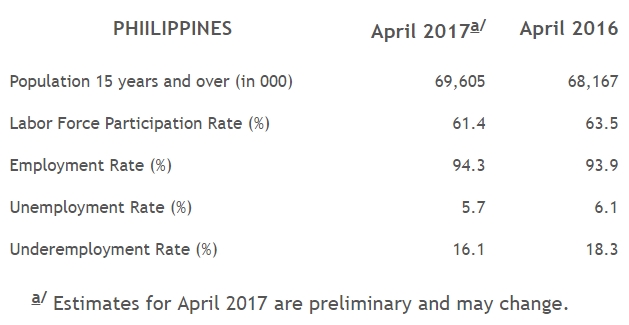PH Unemployment Rate Drops to 5.7% in April
Manila—(PHStocks)—The country’s employment rate in April 2017 was estimated at 94.3 percent, according to data released by the Philippine Statistics Authority (PSA). In April 2016, the employment rate was 93.9 percent.
The top three regions with the lowest employment rates were Ilocos Region (89.6%), National Capital Region (NCR) (92.8%), and CALABARZON (92.9%). The labor force participation rate (LFPR) in April 2017 was estimated at 61.4 percent given the labor force population of 69.6 million. The LFPR in April 2016 was 63.5 percent. The labor force population consists of the employed and the unemployed 15 years old and over.
Workers in the agriculture sector comprised the second largest group making up 26.1 percent of the total employed in April 2017, while workers in the industry sector made up the smallest group registering 18.5 percent of the total employed. In April 2016, workers in agriculture accounted for 25.5 percent of the total employed; while workers in the industry sector, 18.2 percent. The April 2017 LFS results also showed that in the industry sector, workers in the construction and manufacturing subsectors made up the largest groups, accounting for 47.7 percent and 47.5 percent of the workers in these subsectors, respectively.
 Among the occupation groups, workers in the elementary occupations remained the largest group making up 26.8 percent of the total employed in April 2017. In April 2016, such workers made up 26.5 percent of the total employed in that period. Managers comprised the second largest occupation group (16.3%), followed by service and sales workers (15.0%), and skilled agricultural, forestry, and fishery workers (13.5%) in April 2017.
Among the occupation groups, workers in the elementary occupations remained the largest group making up 26.8 percent of the total employed in April 2017. In April 2016, such workers made up 26.5 percent of the total employed in that period. Managers comprised the second largest occupation group (16.3%), followed by service and sales workers (15.0%), and skilled agricultural, forestry, and fishery workers (13.5%) in April 2017.
Employed persons fall into any of these categories: (1) wage and salary workers, (2) self-employed workers without any paid employee, (3) employers in own family-operated farm or business, and (4) unpaid family workers. Wage and salary workers are those who work for private households, private establishments, government or government-controlled corporations, and those who work with pay in own family-operated farm or business. In April 2017, the wage and salary workers made up 61.3 percent of the total employed, with those working in private establishments continuing to account for the largest share. They made up 48.8 percent of the total employed in April 2017 and 48.4 percent in April 2016. The second largest class of workers were the self-employed making up 28.2 percent of the total employed in April 2017 while it was 26.8 percent in April 2016. Unpaid family workers accounted for 6.7 percent of the total employed in April 2017 and 8.3 percent of the total employed in April 2016.
Employed persons are classified as either full-time workers or part-time workers. Full-time workers refer to those who worked for 40 hours or more during the reference week, while those who worked for less than 40 hours were considered part-time workers. Of the total employed persons in April 2017, 60.8 percent were full-time workers, while 37.8 percent were part-time workers. By comparison, in April 2016, full-time workers comprised 65.3 percent while part-time workers, 32.8 percent. In April 2017, workers worked 40.3 hours per week, on average, compared to 42.2 in April 2016.
By definition, employed persons who express the desire to have additional hours of work in their present job, or to have additional job, or to have a new job with longer working hours are considered underemployed. In April 2017, the underemployment rate, which is the percentage of the underemployed to the total employed, was estimated at 16.1 percent. In April 2016, the unemployment rate was 18.3 percent.
Underemployed persons who work for less than 40 hours in a week are called visibly underemployed persons. They accounted for 60.4 percent of the total underemployed in April 2017 and 55.2 percent in April 2016. By comparison, the underemployed persons who worked for 40 hours or more in a week made up 37.7 percent. By sector, 44.4 percent of the underemployed worked in the services sector, while 35.9 percent were in the agriculture sector. Those in the industry sector accounted for 19.7 percent.
The unemployment rate in April 2017 was estimated at 5.7 percent, lower than the unemployment rate in April 2016 which was 6.1 percent. Among the regions, Ilocos Region (10.4%), National Capital Region (NCR) (7.2%) and CALABARZON (7.1%) were the regions with the highest unemployment rates.
Among the unemployed persons in April 2017, 63.7 percent were males. Of the total unemployed, the age group 15 to 24 years comprised 49.5 percent, while the age group 25 to 34, 29.3 percent. By educational attainment, 20.6 percent of the unemployed were college graduates, 13.7 percent were college undergraduates, and 33.5 percent have completed junior high school.
